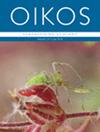驯鹿放牧减少了气候引起的植被变化,并改变了芬诺斯康迪亚冻原的营养相互作用
IF 3
2区 环境科学与生态学
Q2 ECOLOGY
引用次数: 0
摘要
食草动物通过落叶、践踏和增加养分(尿液和粪便)与植被相互作用,推动植物物种组成的变化。随着时间的推移,食草动物对植被的影响不断累积,可能会蔓延到其他营养级,但人们对这种情况如何发生以及何时发生还知之甚少。由于测量跨空间梯度的生物多样性在方法上要求较高,另一种方法是通过维管植物的生物多样性指数来评估。我们采用了为瑞典植物区系开发的生物多样性相关性指数,该指数可估算出与植物物种相关的生物数量,从而量化营养群落的规模。该指数的数值与来自芬诺斯坎迪亚 96 个围栏和成对放牧地块网络的植被数据相结合。我们根据指数值分析了食草动物对植物丰富度和多样性的影响,以及对与植被相互作用的生物数量的影响。我们还探讨了食草动物如何影响高灌木对其他植物的竞争效应,因为植被类型的优势与生物多样性直接相关。植物多样性对放牧没有明显的反应。在围栏地块中,整体植被以及植被亚群草本植物和非果灌木的生物多样性指数值较高,这表明植物-宿主相互作用的数量较多。在两种处理中,草本植物覆盖率与灌木呈负相关,但在没有食草动物的情况下,草本植物覆盖率下降得更快。这项研究强调了在北极地区维持食草动物数量对保护苔原植被结构和生物多样性的重要性。这种将生物多样性指数与植被数据相结合的方法为植物多样性提供了补充信息,尤其是在因方法或时间限制而无法进行完整野外调查的情况下。本文章由计算机程序翻译,如有差异,请以英文原文为准。
Reindeer grazing reduces climate‐driven vegetation changes and shifts trophic interactions in the Fennoscandian tundra
Herbivores drive shifts in plant species composition by interacting with vegetation through defoliation, trampling and nutrient addition: urine and faeces. As herbivore effects on vegetation accumulate over time, they might spillover to other trophic levels, but how and when this happens is poorly understood. Since it is methodologically demanding to measure biodiversity across spatial gradients, an alternative approach is to assess it through biodiversity indices of vascular plants. We employed the Index of biodiversity relevance developed for Swedish flora which provides an estimated number of organisms associated with a plant species, allowing the quantification of trophic community size. Values from this index were coupled with vegetation data from a network of 96 fenced and paired grazed plots across Fennoscandia. We analysed the role herbivory has on plant richness and diversity, and on the number of organisms that interact with the vegetation according to the index values. We also explored how herbivores influence the competitive effects of tall shrubs on other plants since the dominance of a vegetation type links directly to biodiversity. Plant diversity had no clear response to grazing. Overall vegetation and the vegetation subgroups herbs and non‐fruit shrubs had higher biodiversity index values in fenced plots, indicating a higher number of plant–host interactions. Herb cover was negatively related to shrubs in both treatments but with a faster decline in the absence of herbivores. This study highlights the importance of maintaining herbivore populations in the Arctic to conserve the vegetation structure and biodiversity of the tundra. This method of coupling biodiversity indexes with vegetation data provides complementary information to the plant diversity, especially when methodological or time constraints prevent complete field inventories.
求助全文
通过发布文献求助,成功后即可免费获取论文全文。
去求助
来源期刊

Oikos
环境科学-生态学
CiteScore
6.20
自引率
5.90%
发文量
152
审稿时长
6-12 weeks
期刊介绍:
Oikos publishes original and innovative research on all aspects of ecology, defined as organism-environment interactions at various spatiotemporal scales, so including macroecology and evolutionary ecology. Emphasis is on theoretical and empirical work aimed at generalization and synthesis across taxa, systems and ecological disciplines. Papers can contribute to new developments in ecology by reporting novel theory or critical empirical results, and "synthesis" can include developing new theory, tests of general hypotheses, or bringing together established or emerging areas of ecology. Confirming or extending the established literature, by for example showing results that are novel for a new taxon, or purely applied research, is given low priority.
 求助内容:
求助内容: 应助结果提醒方式:
应助结果提醒方式:


